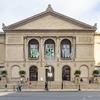More about The Basket of Apples
- All
- Info
- Shop

Sr. Contributor
Paul Cézanne is a pretty big deal in the history of modern painting.
You may be asking yourself, “What could be so special about some apples on a table?” Well, it’s not so much about what he painted, but really more about how he painted. Whereas artists like Leonardo da Vinci and Caravaggio created painstakingly realistic images that faithfully represented objects as they appeared in nature, Cézanne decided that approach wasn’t for him. Instead, Cézanne declared that art is “a harmony running parallel to nature,” which meant that he was definitely not afraid to use his artistic liberty.
Cézanne was what you might call a troubled artist. He was a loner, a socially awkward guy, and was even prone to violent outbursts. It makes sense that his art reflects this struggle with both art history and other contemporary movements like Impressionism and Post-Impressionism. After realizing that the world within the canvas is a totally separate reality from what people experience, Cézanne became obsessed with apple still-lifes and decided to get real weird with it. This resulted in paintings based in some pretty wonky physics. The edges of this table don’t even line up with one another! This was because Cézanne basically threw the rules of classical perspective right in the trash.
Because he was so far ahead of his time, people didn’t really “get” Cézanne for a while. Hailed as a genius by some, like Mary Cassatt, and misunderstood by many others, Cézanne had his first one-man show in France in 1895. Like all great artists, Cézanne did not receive critical acclaim until after his death.
America also had a tough time understanding this apple-obsessed artist. Confused by its crazy styles and abstract tendencies, Americans were just slow on the uptake of modern European art in general. The 1913 Armory Show, which traveled to New York, Chicago, and Boston, introduced Americans to the insanity of the avant-garde. Although artists and collectors knew about Cézanne, this was the first time that he made an appearance to the general, American public. Americans had a pretty tough time accepting that what they were seeing at The Armory Show could be considered art. When the show traveled to Chicago, some were so outraged that a group of students went so far as to burn paintings by Matisse.
We really owe it to the genius of early collectors like Helen Birch Bartlett, who began collecting works by Matisse, Picasso, and Seurat, as well as Cézanne, in the early 1920s after the introduction of modern art to America. Unfortunately, this was still a time when these artworks were just too much for the fragile, American sensibility. Helen and her husband Frederic Clay Bartlett were probably more open-minded than most Americans because of their frequent trips to Europe, where the avant-garde reigned supreme. After Helen’s death in 1926, Frederic gave their whole collection to the Art Institute of Chicago, which established the Helen Birch Bartlett Memorial Collection the first ever collection of modern European art to be put on permanent display in an American museum. Interestingly, this was three years prior to the founding of the Museum of Modern Art in New York and thirteen years before the opening of the Guggenheim, which was then called the Museum of Non-Objective Art. Give it up for Helen Birch Bartlett!
Sources
- Arnason, H.H., and Elizabeth C. Mansfield. History of Modern Art. 7th Edition Upper Saddle River, NJ: Pearson Education, Inc., 2013.
- Art Institute of Chicago. “Historic Collections: The Helen Birch Bartlett Memorial Collection.” Interpretive Resource. http://www.artic.edu/aic/resources/resource/1863. Accessed June 8, 2017.
- Art Institute of Chicago. “The Basket of Apples.” Collections. http://www.artic.edu/aic/collections/artwork/111436. Accessed June 8, 2017.
- Meagher, Jennifer. “Still-Life Painting in Southern Europe, 1600–1800.” The Heilbrunn Timeline of Art History. The Metropolitan Museum of Art. June 2008. http://www.metmuseum.org/toah/hd/sstl/hd_sstl.htm. Accessed June 8, 2017.
- New-York Historical Society Museum and Library. “About.” The Armory Show at 100. http://armory.nyhistory.org/about/. Accessed June 8, 2017.
- New-York Historical Society Museum and Library. “Cezanne.” The Armory Show at 100. http://armory.nyhistory.org/cezanne-pamphlet-cover-only/. Accessed June 8, 2017.
- Voorhies, James. “Paul Cezanne (1839–1906).” The Heilbrunn Timeline of Art History. The Metropolitan Museum of Art. October 2004. http://www.metmuseum.org/toah/hd/pcez/hd_pcez.htm. Accessed June 8, 2017.
Featured Content
Here is what Wikipedia says about The Basket of Apples
The Basket of Apples (French: Le panier de pommes) is a still-life oil painting by French artist Paul Cézanne, which he created c. 1893. The painting rejected naturalistic representation in favor of distorting objects to create multiple perspectives. This approach eventually influenced other art movements, including Fauvism and Cubism. It belongs to the Helen Birch Bartlett Memorial Collection of the Art Institute of Chicago.
Check out the full Wikipedia article about The Basket of Apples















twenty one pilots is a cool band, you should listen to them <3